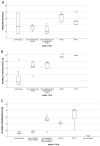Medical face masks offer self-protection against aerosols: An evaluation using a practical in vitro approach on a dummy head
- PMID: 33657178
- PMCID: PMC7928437
- DOI: 10.1371/journal.pone.0248099
Medical face masks offer self-protection against aerosols: An evaluation using a practical in vitro approach on a dummy head
Abstract
Since the appearance of severe acute respiratory syndrome coronavirus 2 (SARS-CoV-2), the question regarding the efficacy of various hygiene measures and the use of personal protective equipment (PPE) has become the focus of scientific and above all public discussion. To compare respirators, medical face masks, and cloth masks and determine if it is recommendable to wear face masks to protect the individual wearer of the mask from inhaling airborne particles, we challenged 29 different masks with aerosols and tested the pressure drop as a surrogate for breathing resistance owing to the mask material. We found that Type II medical face masks showed the lowest pressure drop (12.9±6.8 Pa/cm2) and therefore additional breathing resistance, whereas respirators such as the KN95 (32.3±7.0 Pa/cm2) and FFP2 (26.8±7.4 Pa/cm2) showed the highest pressure drops among the tested masks. The filtration efficacy of the mask material was the lowest for cloth masks (28±25%) followed by non-certified face masks (63±19%) and certified medical face masks (70±10%). The materials of the different respirators showed very high aerosol retentions (KN95 [94±4%] and FFP2 [98±1%]). For evaluating the as-worn filtration performance simulating real live conditions each mask type was also tested on a standardized dummy head. Cloth masks and non-EN-certified face masks had the worst as-worn filtration efficacies among the tested masks, filtering less than 20% of the test aerosol. Remarkably, certified type II medical face masks showed similar (p>0.5) as-worn filtration results (47±20%) than KN95 masks (41±4%) and FFP2 masks (65±27%), despite having a lower pressure drop. Face shields did not show any significant retention function against aerosols in our experiment. Our results indicate that it seems recommendable to wear face masks for providing base protection and risk reduction against inhaling airborne particles, in low-risk situations. In our study, especially EN 14683 type II certified medical face masks showed protective effectiveness against aerosols accompanied by minimal additional breathing resistance. FFP2 Respirators, on the other hand, could be useful in high-risk situations but require greater breathing effort and therefore physical stress for users.
Conflict of interest statement
The authors have declared that no competing interests exist.
Figures




Similar articles
-
High Level Bioaerosol Protection against Infective Aerosols: How Medical Face Masks Compare against Respirators.Can J Infect Dis Med Microbiol. 2022 Oct 22;2022:6978661. doi: 10.1155/2022/6978661. eCollection 2022. Can J Infect Dis Med Microbiol. 2022. PMID: 36317154 Free PMC article.
-
Measuring the fitted filtration efficiency of cloth masks, medical masks and respirators.PLoS One. 2025 Apr 21;20(4):e0301310. doi: 10.1371/journal.pone.0301310. eCollection 2025. PLoS One. 2025. PMID: 40258061 Free PMC article.
-
Discrepancy of particle passage in 101 mask batches during the first year of the Covid-19 pandemic in Germany.Sci Rep. 2021 Dec 29;11(1):24490. doi: 10.1038/s41598-021-03862-z. Sci Rep. 2021. PMID: 34966168 Free PMC article.
-
Effectiveness of face masks for the population.Ann Ig. 2021 Jul-Aug;33(4):347-359. doi: 10.7416/ai.2020.2390. Epub 2020 Dec 3. Ann Ig. 2021. PMID: 33258868 Review.
-
COVID-19 and respiratory protection for healthcare providers.Int J Occup Med Environ Health. 2021 May 27;34(2):307-318. doi: 10.13075/ijomeh.1896.01666. Epub 2020 Nov 24. Int J Occup Med Environ Health. 2021. PMID: 33231204 Review.
Cited by
-
Bacterial contamination potential of personal protective equipment itself in dental aerosol-producing treatments.Odontology. 2024 Apr;112(2):309-316. doi: 10.1007/s10266-023-00848-3. Epub 2023 Sep 13. Odontology. 2024. PMID: 37702832 Free PMC article. Review.
-
From outbreak of COVID-19 to launching of vaccination drive: invigorating single-use plastics, mitigation strategies, and way forward.Environ Sci Pollut Res Int. 2021 Oct;28(40):55811-55845. doi: 10.1007/s11356-021-16025-4. Epub 2021 Sep 3. Environ Sci Pollut Res Int. 2021. PMID: 34480299 Free PMC article. Review.
-
Infection control strategies for healthcare workers during COVID-19 pandemic in German hospitals: A cross-sectional study in march-april 2021.Heliyon. 2023 Mar;9(3):e14658. doi: 10.1016/j.heliyon.2023.e14658. Epub 2023 Mar 17. Heliyon. 2023. PMID: 36945349 Free PMC article.
-
High Level Bioaerosol Protection against Infective Aerosols: How Medical Face Masks Compare against Respirators.Can J Infect Dis Med Microbiol. 2022 Oct 22;2022:6978661. doi: 10.1155/2022/6978661. eCollection 2022. Can J Infect Dis Med Microbiol. 2022. PMID: 36317154 Free PMC article.
-
Re-opening the pediatric pulmonary function laboratory during the ongoing COVID-19 pandemic.Paediatr Respir Rev. 2022 Jun;42:49-52. doi: 10.1016/j.prrv.2022.01.001. Epub 2022 Jan 11. Paediatr Respir Rev. 2022. PMID: 35428587 Free PMC article. Review.
References
MeSH terms
Substances
LinkOut - more resources
Full Text Sources
Other Literature Sources
Medical
Research Materials
Miscellaneous

